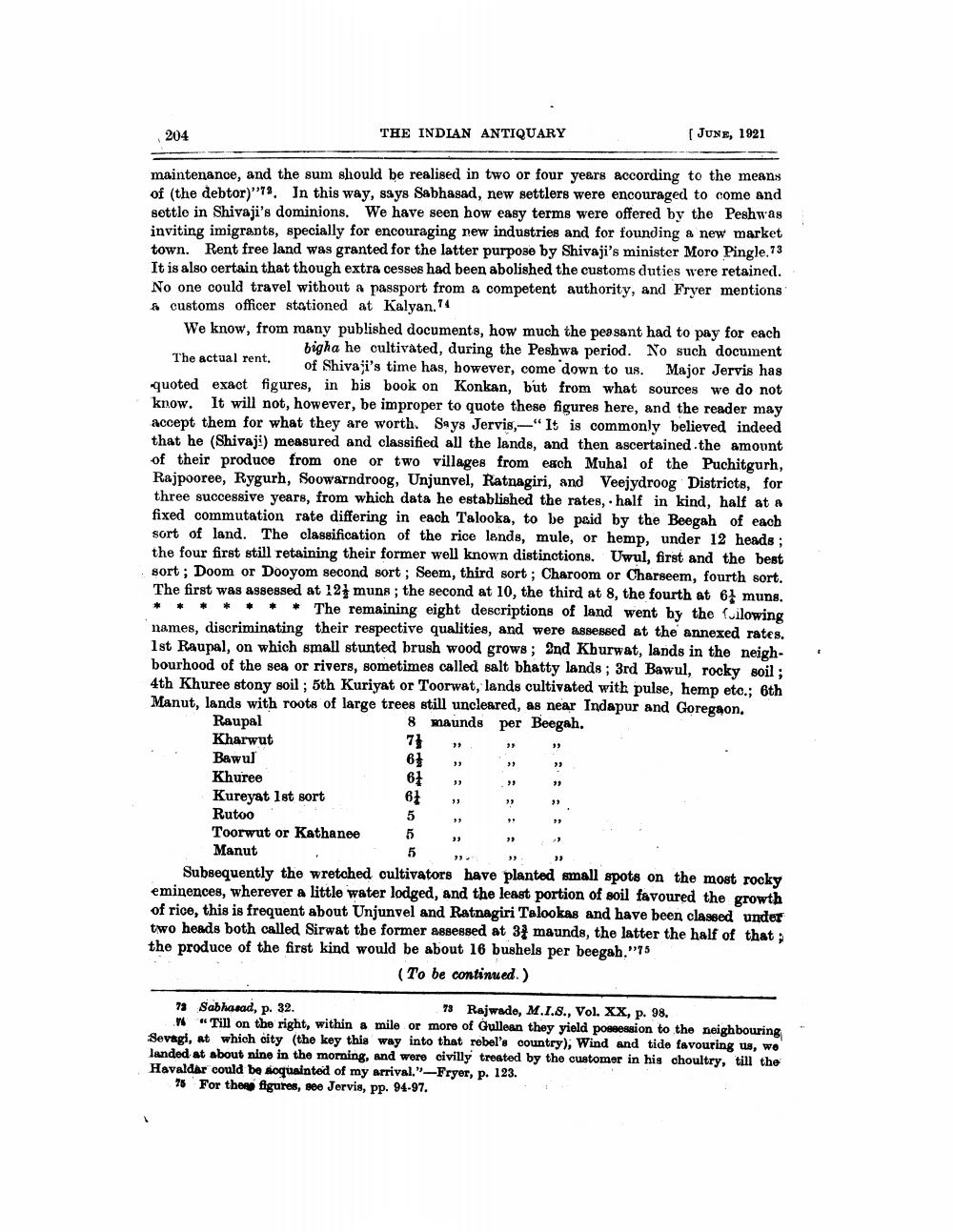________________
204
THE INDIAN ANTIQUARY
JUNE, 1921
maintenance, and the sum should be realised in two or four years according to the means of the debtor)"79. In this way, says Sabhasad, new settlers were encouraged to come and settle in Shivaji's dominions. We have seen how easy terms were offered by the Peshwas inviting imigrants, specially for encouraging new industries and for founding a new market town. Rent free land was granted for the latter purpose by Shivaji's minister Moro Pingle 73 It is also certain that though extra cesses had been abolished the customs duties were retained. No one could travel without a passport from a competent authority, and Fryer mentions A customs officer stationed at Kalyan.14 We know, from many published documents, how much the peasant had to pay for each
bigha he cultivated, during the Peshwa period. No such document The actual rent.
T. of Shivaji's time has, however, come down to us. of Shivali's time has, howev
Major Jervis has quoted exact figures, in his book on Konkan, but from what sources we do not know. It will not, however, be improper to quote these figures here, and the reader may accept them for what they are worth. Says Jervis,-"15 is commonly believed indeed that he (Shivaj) measured and classified all the lands, and then ascertained the amount of their produce from one or two villages from each Muhal of the Puchitgurh, Rajpooree, Rygurh, Soowardroog, Unjunvel, Ratnagiri, and Veejydroog Districts, for three successive years, from which data he established the rates, half in kind, half at a fixed commutation rate differing in each Talooka, to be paid by the Beegah of each sort of land. The classification of the rice lends, mule, or hemp, under 12 heads : the four first still retaining their former well known distinctions. Uwul, first and the best sort ; Doom or Dooyom second sort ; Seem, third sort ; Charoom or Charseem, fourth sort. The first was assessed at 12 muns; the second at 10, the third at 8, the fourth at 61 muns. * * * * * * The remaining eight descriptions of land went by the fuilowing names, discriminating their respective qualities, and were 888essed at the annexed rates. 1st Raupal, on which small stunted brush wood grows; and Khurwat, lands in the neighbourhood of the sea or rivers, sometimes called salt bhatty lands; 3rd Bawul, rocky soil ; 4th Khuree stony soil; 5th Kuriyat or Toorwat, lands cultivated with pulse, hemp etc.; 6th Manut, lands with roots of large trees still uncleared, as near Indapur and Goregaon. Raupal
8 maunds per Beegah. Kharwut Bawul
61 Khuree Kureyat 1st sort
67 » » » Rutoo Toorwut or Kathanee
Manut Subsequently the wretched cultivators have planted small spots on the most rocky eminences, wherever a little water lodged, and the least portion of soil favoured the growth of rice, this is frequent about Unjunvel and Ratnagiri Talookas and have been classed under two heads both called Sirwat the former assessed at 37 maunds, the latter the half of that: the produce of the first kind would be about 16 bushels per beegah,"95
(To be continued.)
67
73 Sabhasad, p. 32.
73 Rajwado, M.I.S., Vol. XX, p. 98. 16 *Till on the right, within a mile or more of Gullean they yield possession to the neighbouring Sevagi, at which city (the key this way into that rebel's country), Wind and tide favouring us, we landed at about nine in the morning, and were civilly treated by the customer in his choultry, till the Havaldar could be soquainted of my arrival."-Fryer, p. 123.
75 For the figures, see Jervis, pp. 94-97.




